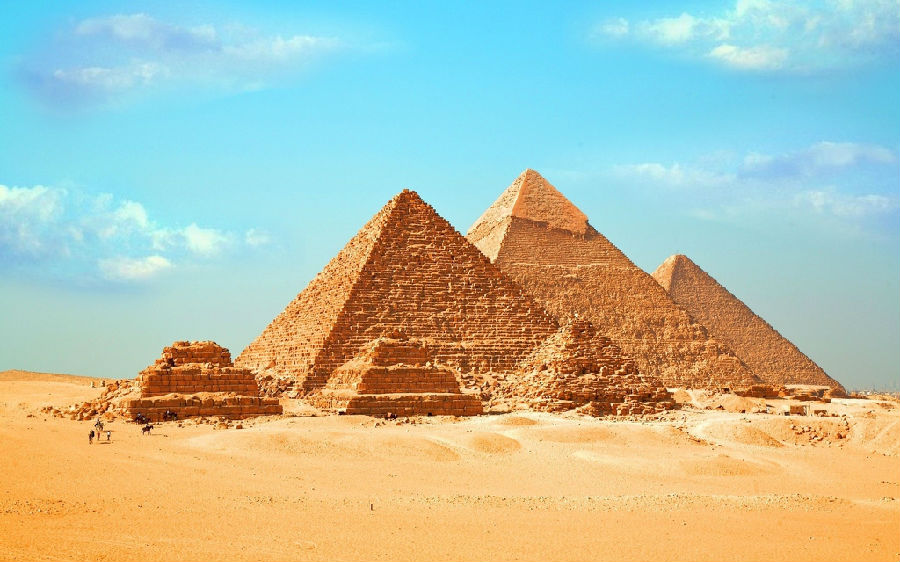Listen to part of a lecture in an archaeology class.
聽一段節選自考古學課堂的講座。
Professor: The Great Pyramid of Giza in Egypt might be the most famous building in the world.
教授:埃及吉薩金字塔也許是世界上最著名的建筑。
We know exactly when it was built.
我們知道建造它的確切時間。
Construction started in 2547 B.C.E., about 4500 years ago.
始建于公元前2547年,約4500年前。
We know who had it built.
我們知道是誰建造了它。
That was the pharaoh Khufu.
胡夫法老。
And we know who oversaw its construction—the pharaoh's brother.
而且我們知道誰監督著它的建設——法老的兄弟。

We know so many things about it, but the funny thing is: we still don't know exactly how it was built.
我們知道關于它的很多事情,但有趣的是我們仍不知道它到底是怎么建造的。
This picture will give you an idea of the size of the Pyramid and the size of the blocks it's made out of.
這張照片給你介紹了金字塔與建成金字塔的方磚大小。
About two million stone blocks were used to build the Great Pyramid and they are incredibly massive.
建造大金字塔用了約200萬石塊,而且它們極其龐大。
The average weight is two and a half tons.
平均重量是2.5噸。
The problem that has puzzled scholars for centuries is how were these blocks lifted up the height of this massive structure and then fit into place and without the benefit of modern technology.
幾個世紀讓學者們困惑的問題是在不利用現代科技的情況下,這些磚塊是如何舉到這個大型建筑物的高度,然后放到恰當的位置。
Of course, there've been a lot of theories over the centuries.
當然幾個世紀以來有很多理論存在。
The oldest recorded one is by the Greek historian Herodotus.
最古老的記錄是來自希臘的歷史學家希羅多德。
He visited Egypt around 450 B.C.E. , when the Pyramid was already 2000 years old.
他在大約公元前450年參觀過埃及,這時金字塔已經建造了2000年之久。
His theory was that cranes were used, much like we use cranes today to construct tall buildings.
他的理論是用到了起重機,就像我們今天用起重機建造高樓一樣。
And Herodotus may have seen Egyptians using cranes made of wood.
希羅多德也許看到埃及人用木制的起重機。
But the problem with this theory has to do with simple mechanics.
但這個理論的問題是與簡單的力學有關。
A crane needs a wide and sturdy base to stand on or it will fall over.
一個起重機需要廣而結實的底座支撐,否則它將會倒塌。
Well, as you get toward the top of the Pyramid, there's really no place for a crane to stand.
當你到金字塔的頂端時,那里確實沒有地方留給起重機。
The stone blocks are too narrow to provide a base.
石塊太窄無法為底座讓位。
Well, so much for that theory.
那么,這個理論就講到這里。
The next one has to do with the use of a ramp that would allow workers to drag a stone block up the side of the structure.
下一個與坡道使用有關,它允許工人從建筑的一側將石塊拉上去。
Of course the ramp can't be too steep.
當然坡道不能太陡。
It has to have a long gentle slope. And that's the problem.
它應該有一個長長的緩坡,而這就是問題。
If you build a ramp with a slight slope up to the top of a Pyramid that's over 130 meters high, it would have to be almost two kilometers long.
如果你要建造一個抵達金字塔頂130多米高的緩坡坡道,那么它幾乎是兩公里長。
Well, the Pyramid is built on a flat area called the Giza Plateau.
金字塔建在吉薩平原,這個平坦的地區。
The Plateau is simply not big enough to accommodate a two-kilometer-long ramp.
這個平原沒有足夠大的地方容納一個兩公里長的坡道。
OK. So what now?
好的。那么現在怎樣?
Well, if you've ever driven on a mountain road, you'd know that it has a lot of twists and turns and bends in it because that's how engineers keep the road from having to be too steep.
如果你曾在山路上開過車,你會知道山路上有很多迂回曲折的彎路,因為工程師以此防止道路過陡。
So why not wrap the ramp around the Pyramid?
那么為什么不用坡道環繞在金字塔周圍?
Building the ramp around it as you go.
按照你想的在它的周圍建造坡道。
Sounds like a pretty good idea.
聽起來是個好主意。
Except it's got a serious problem.
除了有一個嚴重的問題。
See...one of the most remarkable things about the Great Pyramid is how accurate the proportions are.
你看……大金字塔最為非凡的一件事是它的比例十分精確。
The dimensions are almost perfect.
尺寸幾乎完美。










